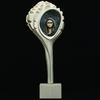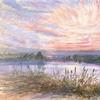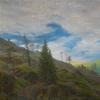
Dan Christensen: The Harmonious Turbulence of the Universe | Spray Paintings (1988-1994)
https://berrycampbell.com/exhibition/140/
Berry Campbell is pleased to announce its fourth exhibition of paintings by Dan Christensen, focusing on his spray paintings from 1988 through 1994. In the late 1960s, Christensen became known amongst dealers, collectors and museums for his innovative use of the spray gun, creating colorful swirling, swooping lines on large-scale canvases. After experimenting in this and other media/techniques for decades, Christensen decided to revisit the sole use of the spray gun. Re-exploring the union of color and form, line and paint. Created during a time when Christensen was settled in his life and well-established in his art, the sprays he created between 1988 and 1994 seem outward- rather than inward-driven, suggestive of an artist reflecting not as much on himself as on the cosmic and eternal.
The works from this show fall into three groups: spray portraits and sprays with single or multiple spheres. The spray portraits consist of orbs surrounded by concentric circles, cut off at a work’s edges to imply a sense of limitless space. In these images, Christensen explored scale with reference to the figurative art of his early career. One of Christensen’s most notable examples of his spray portraits is Blue Boy, 1988, in the collection of the Nelson-Atkins Museum of Art, Kansas City, Missouri. Christensen’s lyrical abstract painting references Gainsborough’s iconic Blue Boy, 1770, in the collection of The Huntington Library, San Marino, California.
Single-spot sprays are necessarily centripetal, but they are far from inert. These single spots call to mind the targets of Jasper Johns and Kenneth Noland, but Christensen animated this form with his own stamp, producing blurred shapes that seem to spin and react magnetically and atmospherically. Multi-spot works are relationship-driven. Some consist of two equal spheres, while other works feature two or more unequal shapes, undulating and pulsing across the surface of the canvas.
When Christensen was pressed for an explanation of the meaning of his art, he may have had the sprays of 1988 through 1994 in mind in the answer he provided: “the harmonious turbulence of the universe.” As his friend, the art dealer Douglas Drake recalled, the phrase, which he may have coined or borrowed, became almost his mantra. Dan Christensen: The Harmonious Turbulence of the Universe | Spray Paintings (1988-1994) opens February 10 and continues through March 12, 2022. Berry Campbell represents the Estate of Dan Christensen.
ABOUT THE ARTIST
Throughout his career, Dan Christensen was always moving forward but also looking back. His method was one of constantly seeking new ways of painting, and one inquiry would lead to another. However, in the process, he often returned to methods and materials he had explored earlier, reincorporating them in new iterations. With such a recombinant approach, his work is a commentary on the artistic process itself and becomes a cohesive whole when his oeuvre overall is considered.
Christensen first received recognition for his innovative use of the spray gun in the late 1960s. His early sprays were heralded by the critics for epitomizing an exuberant type of painting that broke from the sober formalism of Minimalism and that reclaimed art traditions of the postwar years. In 1967, Christensen purchased his first spray gun from an autobody shop in a day before the airbrush became a popular artistic medium. After at first seeking control over a difficult technique in works with grid formats, he laid his canvases on the floor and loosened up to create swirling, looping arcs with muscular force on huge vividly hued fields. While re-invoking the mark-making of action painting, the soft-edged gestures were not self-consciously gut-wrenching, but instead evinced a love of color and autonomous freedom, drawing the viewer into a directly visceral lyrical engagement.
In 1969, Christensen put aside the spray gun out of a desire for greater physical engagement in art making. In the two decades that followed, he continued to take risks with nontraditional media, and the new paints, gels, and extenders that came on the market. In the works of these years, he modified the viscosity of his surfaces with tools and staining methods in several series. In the stain paintings of 1976–88, he used sticks, brushes, and turkey basters to produce calligraphic drawings into which he poured diluted pigments. In his mood-evocative images, he drew from his responses to the natural world, especially in Springs, Long Island, New York, where he spent summers and eventually lived full-time, with his wife, the artist Elaine Grove, and their two young sons.
The thinned surfaces of the stains and their vivacity in new figure/ground relationships may have spurred Christensen to revisit the spray gun. From 1988 through 1994, he again used spray as his sole medium, re-exploring the union of color and form, line and paint. However, here instead of looping the spray across the surface, he set spherical shapes in auras of light. Describing a show of these works at ACA Galleries in 1993, Lilly Wei called them “essentially modernist paintings,” commenting that in them, “Op art, Color Field, and Minimalism are brought up to date with an array of brilliant, often metallic colors played off against each other.”[1] Brooks Adams remarked of Christensen’s show in 1991 at Salander O’Reilly Gallery: “the allover speckled texture of the acrylic spray paint, especially effective where two colors overlap yet do not blend, creates a feeling of low relief and suggests a blazing Pointillist sun.”[2] In addition, instead of the lyricism and playfulness of the sprays of the 1960s, the new sprays, created with shimmering iridescent paint, are more metaphysical. Continuing an ancient lineage in art of cosmological and celestial symbolism, their shimmering shapes imply the Pythagorean harmony of the spheres as well as atomic energy and matter.
Christensen received a National Endowment Grant in 1968 and a Guggenheim Fellowship in 1969. His paintings are held in over thirty museum collections, including the Albright-Knox Gallery, Buffalo, New York; the Art Institute of Chicago; the Cleveland Museum of Art; the Denver Art Museum; the Detroit Institute of Arts; the Fine Arts Museums of San Francisco; the High Museum, Atlanta; the Hirshhorn Museum and Sculpture Garden, Washington, D.C.; the Indianapolis Museum of Art; the Metropolitan Museum of Art, New York; the Museum of Fine Arts, Boston; Museum für Moderne Kunst, Frankfurt am Main, Germany ; the Museum of Fine Arts, Houston; the Museum of Modern Art, New York; the Nelson-Atkins Museum, Kansas City; Princeton Art Museum, New Jersey; the Seattle Art Museum; the Saint Louis Art Museum; the Seattle Art Museum; Smithsonian American Art Museum, Washington, D.C.; the Solomon R. Guggenheim Museum, New York; the Wallraf-Richartz Museum, Cologne, Germany; the Whitney Museum of American Art, New York; and many others. Berry Campbell Gallery in Chelsea represents Christensen’s estate.
ABOUT THE GALLERY
Christine Berry and Martha Campbell opened Berry Campbell Gallery in the heart of Chelsea on the ground floor in 2013. The gallery has a fine-tuned program representing artists of post-war American painting that have been overlooked or neglected, particularly women of Abstract Expressionism. Since its inception, the gallery has developed a strong emphasis in research to bring to light artists overlooked due to race, gender, or geography. This unique perspective has been increasingly recognized by curators, collectors, and the press. The gallery’s contemporary program continues this exploration. Contemporary works were acquired by the Museum of Fine Arts, Houston, Texas; National Gallery of Art, Washington, D.C.; Nassau County Museum of Art, Roslyn, New York; Smithsonian American Art Museum, Washington, D.C.; Sheldon Museum of Art, Lincoln Nebraska; and the Telfair Museums, Savannah, Georgia.
Berry Campbell has been included and reviewed in publications such as Artforum, Architectural Digest, ArtNews, Art & Antiques, The Brooklyn Rail, the Huffington Post, Hyperallergic, East Hampton Star, Artcritical, Luxe Magazine, the New Criterion, the New York Times, Vogue, Wall Street Journal, and Whitehot Magazine of Contemporary Art.
Berry Campbell is located at 530 W 24th street, New York, New York. The gallery is open Tuesday – Saturday, 10 a.m. – 6 p.m.
[1] Lilly Wei, “Dan Christensen at ACA Galleries,” Art in America 81 (July 1993), p. 33.
[2] Brooks Adams, “Dan Christensen at Salander O’Reilly and Douglas Drake,” Art in America 79 (December 1991), p. 107.
- Contact:
- info@berrycampbell.com
- 2129242178












100x100_c.jpg)



